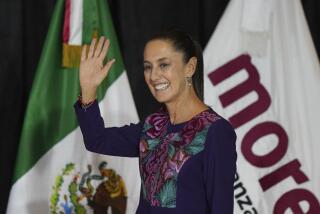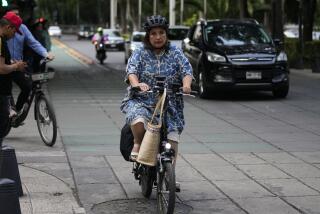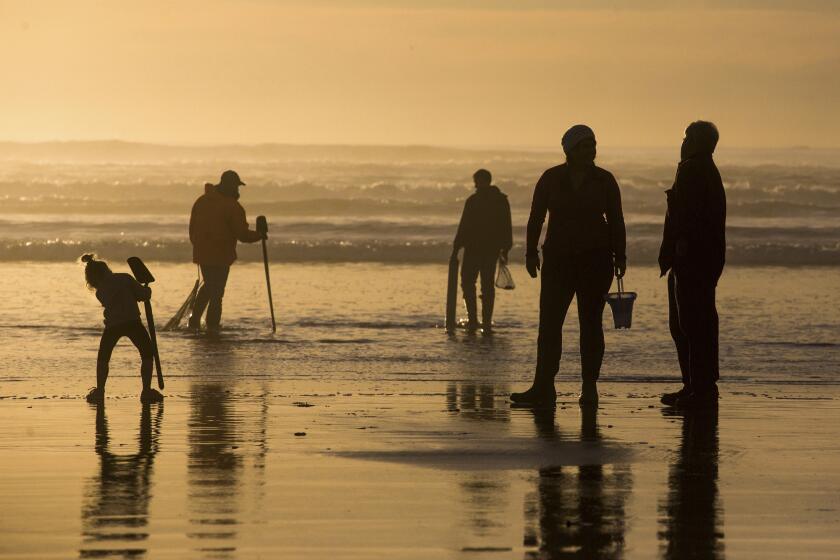Patient Patients : Baja Villagers Are Willing to Wait for the Flying Samaritans, Who Keep Offering Free Monthly Medical and Dental Clinics Despite Summer Doldrums
The three women were the first to arrive. They extricated themselves from the crowded jitney that plies Highway 1 and stood there for a moment, gazing down a paved side road. A quarter of a mile away, where the pavement trailed off into a dusty track, stood a compound of white buildings. They appeared empty and abandoned.
“Will the Samaritanos be here today?” one of them asked a man standing nearby.
The man shrugged noncommittally.
The three, escaping the fierce Baja California sun, scurried toward a little grocery store with a shady terrace, settling on a bench to await the arrival of the Flying Samaritans. Members of the volunteer medical group’s Foothill chapter, many of whose members are from the San Gabriel Valley, were due for a monthly visit, bringing free medical care for residents in and around this tiny settlement.
For many in the farms and outposts around Punta Prieta, the monthly clinics offer the only medical care available.
“Yes, we have our own doctors,” deadpanned one of the women, Carolina Saldana, a 52-year-old resident of a cooperative farm 50 miles to the south. “Their patients die.”
Saldana was there for a blood pressure condition and a swollen eye, and her 17-year-old daughter, Guillermina, had come for treatment of a sore back. Maria de la Paz, 68, a stocky woman in a flowered dress, hoped to have a couple of teeth pulled. “It has been throbbing for eight days now,” she said, opening her mouth to point to the offending teeth.
Things move slowly in Punta Prieta, a collection of a dozen small buildings at a bend in the highway, about 480 miles south of Los Angeles. The women waited stolidly for two hours before a twin-engine Cessna 310 swooped down from above, veered to the south and settled onto the little military landing strip across the road. Shortly afterward, a single-engine Beech Debonaire flew in.
Seven Americans gathered on the strip and, holding boxes and bags of equipment, walked toward the compound, a state-owned highway maintenance facility. They had been delayed by some dicey weather to the north, they said.
Leading the way was Sam Hernandez, the earnest clinic coordinator, clucking nervously over his charges. So far, things were not going smoothly, he said. The August doldrums had struck. “All our doctors and dentists dropped out this time,” he said. The group, which on past visits had included as many as three dozen medical specialists on a dozen airplanes, was left this time with two registered nurses, a dental hygienist, a medical assistant, two pilots and Hernandez.
But they would hold their clinic nevertheless, said Hernandez, an estimator for a Pasadena contractor. “We won’t be able to pull any teeth,” he said, “but we can do a lot of other things.”
The small group was carrying on a 26-year tradition of charity. It began in 1961, when two San Diego women in an airplane were forced down by bad weather in El Rosario, about 100 miles northwest of Punta Prieta. The two, impressed by the generosity of the townspeople, returned with donations of food and clothing. They also brought along a doctor, who set up a makeshift clinic at a kitchen table.
Conditions have improved vastly at most of the 25 fly-in clinics now operated by about 1,500 “Sams,” as the volunteers, who pay their own way and even chip in for airplane fuel, call themselves. All the clinics are filled with donated medical and dental equipment, and their shelves are laden with medicines.
But the one in Punta Prieta, run by the Foothill chapter, is probably the most primitive, Hernandez said. Housed in a small building with fiberboard walls and a corrugated roof, stifling under the assault of the sun, it lacks even running water or electricity. There are two small examining rooms, a dental room and a “pharmacy,” which doubles as an examination room.
As the nurses got ready for business, pilot Roger Helizon, a Jet Propulsion Laboratory engineer who flies out of the El Monte Airport, revved up a portable generator.
Word of the Samaritans’ arrival spread quickly through the sleepy settlement. Before Hernandez’s daughter, Diane, the clinic’s clerk for that day, could begin compiling a list of patients and their ailments, a dozen people had congregated in front of the building.
Registered nurse Sharon Bogdanovic, ordinarily a risk management specialist for CIGNA Health Plans in Glendale, hustled the first patient, Carolina Saldana, to her command post at a table in the pharmacy, and the clinic was on its way. Bogdanovic poked and probed the patient, peering deeply into her eyes.
“It looks like an allergy to me,” she said in American-inflected Spanish, talking over the roar of the generator. “If I give you medicine for the allergy, it will raise your blood pressure.”
Dental hygienist Betty Walters, who works for a dentist in Simi Valley, picked away at accumulations of tartar on a boy’s teeth. “There are tremendous amounts of minerals in the soil here, so their teeth are quite good,” she said. “But when they do have a problem, like a cavity, it tends to get bombed out. That means extractions.”
On First Mission
Marty Garrido, an obstetrical nurse from Los Angeles County-USC Women’s Hospital, on her first Samaritan mission, examined a woman in a tiny curtain-enclosed room.
“Get me a menstrual history on her,” Bogdanovic said, turning away from her own patient.
Hovering at the edge of the room was a girl in a flower-print outfit. She shyly introduced herself. “Ah, Rosa Osuna,” Bogdanovic said pleasurably, recognizing the name. “We have your scholarship money here.” She dug into a bag and pulled out an envelope.
This was money raised by the chapter at fund-raising events, such as a post-Christmas “white elephant” sale, she said. Volunteers raised enough money to pay the required secondary school tuition for eight junior high school graduates with high grades, she added.
Outside the building, Hernandez, a beefy man in a polo shirt and a sun visor, played the harried administrator.
“We’re just too cramped here,” he told the supervisor of the state facility. “I’ve had 120 people lined up on both sides of the building, waiting to see doctors. Our people work five days a week up there. They’re not going to want to come down here and work in 100-degree heat in these circumstances.”
He pointed to another small building the group uses on overflow days. “The doctors have to use walkie-talkies so that they can call over to the pharmacy to find out what’s available,” he said. The supervisor promised to try to get more space.
Hernandez turned his attention to the line of patients. “Keep it rolling,” he said to the medical staff.
“Give me a break, Sam,” said Bogdanovic, who was prescribing a course of treatment to a woman with a swollen toe and preparing to examine a 3-year-old boy with an earache.
Hernandez’s concern was getting the planes in the air before dark. The group was scheduled to run a clinic the next day at Bahia de los Angeles, another small community 50 miles away on the Gulf of California. “They don’t have lights on the runway,” he said. “The last time we were late, we had to get trucks out there to turn on their headlights.”
By the end of the afternoon, the Sams had seen 25 patients, including a woman with abdominal pains that could have been either ovulation or appendicitis, Bogdanovic said. They instructed her to be ready for an emergency trip to a hospital.
“But potentially the most difficult case was an elderly man,” Bogdanovic said. He was complaining of chest pains. “I stuck the stethoscope on his chest, and he was doing a rumba in there,” she said. She directed him to Ensenada for an electrocardiogram.
Partly Satisfied
The three women who had waited patiently earlier in the day came away only partly satisfied. The youngest was disappointed to find that a chiropractor had not made the trip, and the doleful de la Paz could not be treated by the dental hygienist.
“She needs three extractions,” Walters said. “The teeth are so broken I can’t get the forceps on them.” Hernandez suggested that de la Paz travel to Bahia de los Angeles, where there is a practicing dentist.
But Carolina Saldana walked away triumphantly. Not only had she been given aspirin for her allergy, but she had received a clean bill of health. After a month on a salt-free diet, her blood pressure had dropped significantly.
As the medical staff headed for the planes in the late afternoon, the three women stood stolidly by the side of the highway, waiting for the jitney to take them home.
More to Read
More to Read
More to Read
Start your day right
Sign up for Essential California for news, features and recommendations from the L.A. Times and beyond in your inbox six days a week.
You may occasionally receive promotional content from the Los Angeles Times.






